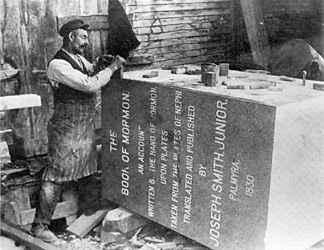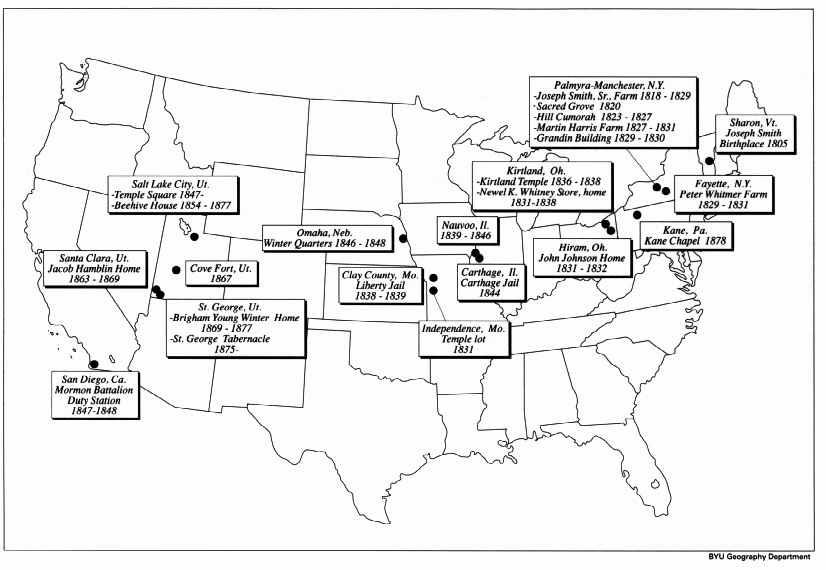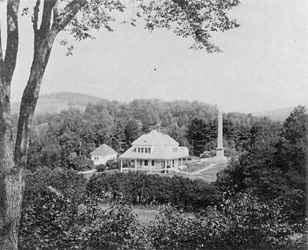Return to About Mormons home

A stonemason prepares the
base of the obelisk erected in 1905 at Joseph Smith's birthplace
in the township of Sharon, Vermont. The inscription is taken from
the Title Page of the Book of Mormon and emphasizes the Prophet's
role as translator to the book. |
|
Related websites:
|
by Richard H. Jackson
The sites of historical importance to Latter-day
Saints include those associated with Christianity in general (the
Holy Land, Jerusalem, Bethlehem, Jordan River, Mount of Olives,
etc.), as well as those directly related to LDS beliefs. The
latter mainly include places in the United States associated with
the founding and organization of THE CHURCH of JESUS CHRIST of
Latter-day Saints and its subsequent migrations west. LDS
historical sites are important to individual members because of
the Church's emphasis on its history and cultural roots rather
than as formal pilgrimage destinations (see History, Significance
to Latter-day Saints). Church members commonly visit these sites
as tourists and, in the process, gain greater personal
understanding of the History of the Church and its beliefs.
Many historical sites in the United States were
obtained through the efforts of such individuals or entities as
Joseph F. Smith, Heber J.
Grant, Willard W. Bean, Wilford C. Wood, and the Corporation
of the Presiding Bishopric of the LDS Church. Most of these sites
have been restored to the time of the historical events and are
staffed by local unpaid volunteers or missionaries.
Visitors centers are located at several sites,
and are free and open to the public. Each location includes
displays and literature explaining the site and its significance
in Church history. One such site is the Joseph Smith Memorial in
Sharon, Windsor County, Vermont. Joseph Smith was born here on
December 23, 1805. In 1905 the Church erected a 38.5-foot-high
granite monument to commemorate the 38.5 years of his life. A
full-time missionary couple live at the home.
Near the village of Palmyra, New York, in the
township of Palmyra, is located the site of the log house in
which the Smiths resided from 1817 to the early or mid-1820s, and
again intermittently until late 1830. In the adjacent township of
Manchester is the Smith family farm, existing frame home, sacred
grove, and also the hill Cumorah only a few miles southeast of
the home. The Sacred Grove is where the boy Joseph received his
first vision, the initial event in the restoration of the Church.
Latter-day Saints believe that the young Joseph Smith was
directed by the angel
Moroni to retrieve from the hill Cumorah the gold plates from
which the Book of Mormon was translated. The first edition of the
Book of Mormon was printed in the Grandin Press Building in
Palmyra. A mile and one-half north of Palmyra is the farm of
Martin Harris, a portion of which was sold to finance the
publication of the Book of Mormon. Thirty miles to the southeast
is the Peter Whitmer farm in Fayette, New York, where the Church
was formally organized in 1830. Yet another hundred miles
southeast from Fayette is harmony, pennsylvania, where the
majority of the Book of Mormon was translated by Joseph Smith and
written down by Oliver
Cowdery.
Joseph Smith moved his family to Kirtland, Ohio,
in early 1831. They remained there until January 1838, when they
fled to Missouri to escape mob violence. Events of importance in
the life of Joseph Smith that occurred in Kirtland include
receiving many revelations now found in the Doctrine and
Covenants and the construction of the first Latter-day Saint
temple. The whitney store was the location of many of these
events and has been restored. The Kirtland Temple was dedicated
on March 27, 1836. It is owned today by the Reorganized Church of
Jesus Christ of Latter Day Saints (rlds).
At Independence, Jackson County, Missouri, an LDS
visitors center is situated on a portion of the temple lot
dedicated by Joseph Smith in 1831. Twelve miles to the north is
Liberty Jail in Clay County, Missouri, where Joseph was
imprisoned from December 1, 1838, to April 6, 1839. Here he
received sections 121-123 of the Doctrine and Covenants. The
reconstructed remnant of the jail stands today as a reminder of
the trials experienced by the Prophet for his beliefs, of the
faithfulness of his followers (some of whom shared the jail with
him), and of the suffering of his wife, Emma Smith, and his
children during the harsh winter while he was imprisoned.
Northeast of Liberty are the historic sites of Far West, in Caldwell
County, Missouri, and Adam-ondi-Ahman, in Daviess County,
Missouri.
After Temple Square in Salt Lake City, Nauvoo is
the second most visited historic location in the Church. Joseph
Smith moved to the village of Commerce in Hancock County,
Illinois, on May 10, 1839. Purchased by the Church, Commerce was
renamed Nauvoo and became a major destination for converts to the
Church, reaching a population in excess of 11,000 in 1845, and
some 20,000 in the greater area. The Church has obtained a number
of the buildings and sites owned by early members in Nauvoo and
has restored or reconstructed them to show what life was like for
the Saints in Nauvoo.
Near Nauvoo is the town of Carthage, the county
seat for Hancock County. Here Joseph Smith was imprisoned on June
25, 1844, and murdered by a mob on June 27. Nauvoo and Carthage
Jail are supervised by the Illinois Peoria Mission and full-time
missionaries staff them.
Following the martyrdom, the Saints, under the
direction of Brigham Young, left Nauvoo in the winter of 1846,
founding a number of temporary settlements en route to the West.
Winter quarters, Nebraska (now Florence, a suburb of Omaha), on
the west bank of the Missouri River, and Kanesville, Iowa (now
council bluffs), on the east bank, were the locations of a large
settlement in the fall and winter of 1846-1847, remaining there
until 1852. The Winter Quarters cemetery is all that remains of
this historical site today.
The Mormon Trail to Utah has a number of
monuments and historic sites. Salt Lake City has numerous
historical sites. Temple Square with the temple, tabernacle,
assembly hall, and visitors center is the most visited site in
the Church. Other sites include "this is the place"
monument, the Beehive and Lion houses built and occupied by
Brigham Young, and the nearby cemetery with his grave.
The Church also maintains three historic sites in
St. George, Utah: the Brigham Young winter home, representing the
LDS expansion southward along the valleys of the Intermountain
West; the St. George Tabernacle, an epitome of the construction
of large assembly halls in the major communities settled by
Latter-day Saints; and the St. George Temple, the first temple
completed in Utah. The temple's dedication in 1877 demonstrated
the commitment of the Latter-day Saints to temple work and to
establishing permanent communities in the Intermountain West. It
is an important example of LDS architecture of the period. And in
nearby Santa Clara stands the home of Jacob Hamblin, one of the
earliest missionaries to the Indians in southern Utah.
These and other historic sites serve as reminders
of the humble yet extraordinary beginnings of the Church and of
the sacrifices made by those individuals who committed their
lives to follow its teachings.
(See Daily Living home page; Church History home page)
Illustrations

Church historical sites with
visitors centers, 1990.

Visitors center and monument
near Sharon, Vermont, at the birthplace of the Prophet Joseph
Smith. The Obelisk rises 38.5 feet—one foot for each year of
Joseph Smith's life. This cottage and monument were dedicated on
December 23, 1905, the centennial anniversary of the Prophet's
birth. Courtesy University of Utah.
LDS HISTORICAL SITES
WITH FULL-TIME STAFF
|
| Main Historic Dates 1805
1817-1818
1820
1823-1827
1827-1831
1829-1830
1829-1831
1831-1833
1831-1833
1831-1838
1831-1838
1836-1838
1838-1839
1839-1846
1844
1846-1848
1847
1847-1848
1854
1863-1869
1867
1869-1877
1875 (Ded.)
1878 (Est.)
|
Place/Location Joseph
Smith Memorial; Sharon, Vt.
Joseph Smith Farm; Manchester, N.Y.
Sacred Grove; Manchester, N.Y.
Hill Cumorah; Manchester, N.Y.
Martin Harris Farm; Palmyra, N.Y.
Grandin Press Building; Palmyra, N.Y.
Peter Whitmer, Sr., Farm; Fayette, N.Y.
John Johnson Home; Hiram, Ohio
Independence Temple Site; Independence, Mo.
Newel K. Whitney Store; Kirtland, Ohio
Newel K. Whitney Home; Kirtland, Ohio
Kirtland Temple (RLDS owned and staffed); Kirtland,
Ohio
Liberty Jail; Liberty, Mo.
Nauvoo (LDS and RLDS sites); Nauvoo, Ill.
Carthage Jail; Carthage, Ill.
Winter Quarters; Omaha (Florence), Nebr.
Temple Square; Salt Lake City, Utah
Mormon Battalion Duty Station; San Diego, Calif.
Beehive House; Salt Lake City, Utah
Jacob Hamblin Home; Santa Clara, Utah
Cove Fort; Cove Fort, Utah
Brigham Young Winter Home; St. George, Utah
St. George Tabernacle; St. George, Utah
Thomas L. Kane Memorial Chapel; Kane, Pa.
|
Bibliography
Burton, Alma P. Mormon Trail from Vermont to
Utah: A Guide to Historical Places of The Church of Jesus Christ
of Latter-day Saints. Salt Lake City, 1966.
Kimball, Stanley B. Historic Sites and Markers
Along the Mormon and Other Great Western Trails. Urbana, Ill.,
1988.
Oscarson, R. Don, and Stanley B. Kimball. The
Travellers' Guide to Historic Mormon America. Salt Lake City,
1990, revised.
Encyclopedia of Mormonism, Vol. 2, Historical
Sites
Copyright © 1992 by Macmillan Publishing
Company


